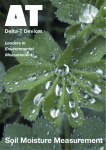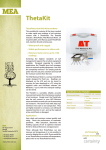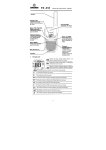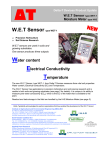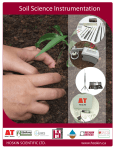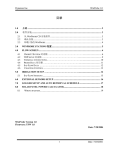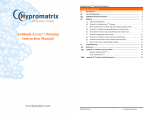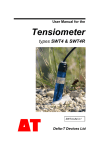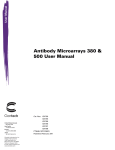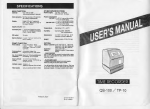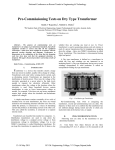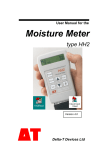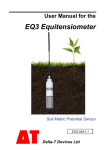Download Delta-T Soil&Plant 12page
Transcript
05 20 Soil and Plant Water Measurement Delta-T Devices ThetaProbe type ML2x G G G G ±1% accuracy Easy data logger connection (DC in DC out) Excellent temperature and salinity stability Dual purpose: either hand-held for spot readings or left in-situ for data logging The ThetaProbe type ML2x measures volumetric soil moisture content to within 1%. The ML2x has decisive advantages over other technologies, offering precision and reliability at an affordable price New low cost logging options for 2005 DL6 and GP1 Data Loggers See separate data sheets for details. Simple to use With the ThetaProbe type ML2x it’s easy to make reliable, accurate soil moisture measurements. Simply insert the probe into the soil, connect to your data logger or meter, provide 5-15V DC at 20mA, and within seconds you can be measuring soil moisture. Calibration After a single two-point gravimetric calibration, ThetaProbes will meet their full 1% accuracy specification for your specific soil (or other medium). For convenience, many users simply apply one of the two standard calibrations supplied by Delta-T. With these "generalised" mineral or organic calibrations, 5% accuracy can be achieved. The ML2x has a predictable saline response (which declines as salinity increases); it can be used even in very saline soils - up to 2000 mS.m-1. Please see the table on page 8 for further information on accuracy and calibration. Applications Typical application areas include irrigation, hydrology, civil engineering, soil water profiling, pollution monitoring, remote sensing validation and forestry. Wherever a vertical soil moisture profile is required, Profile Probes should be considered (see PR2 data sheet), however, it should be noted that ThetaProbe accuracy is ±1%, compared to the Profile Probe’s ±3%. Horticulture and agriculture ThetaProbes can be used in a wide range of soils, composting and other growing media. Because they are so compact, ThetaProbes can be inserted into plant pots, or may be positioned horizontally in a seed tray (they require a minimum 50mm depth of compost). Composting The ML2x can be placed in composting material where it can tolerate temperatures up to +70°C. The accuracy between 40 and 70°C is ±2%, but media density and contaminant levels may affect the accuracy attainable (and the lifespan of the probe). Irrigation Accuracy, ease of use and speed of response make the ThetaProbe well suited to irrigation applications. Readings can be used to optimise irrigation scheduling, or ThetaProbes can be installed as part of an automatic irrigation system. Environmental monitoring Long term studies of global climate and local environments require the monitoring of landatmosphere interactions, and soil water is increasingly seen as one of the critical components. Most automatic weather stations (including all Delta-T systems) can be expanded to include one or more ThetaProbes - as easily as adding, say, another temperature sensor. Data logging and readout Most types of data logger can provide the 5 - 15V DC required to power the ThetaProbe, and will accept its 0 - 1V DC output signal. Up to 60 ThetaProbes can be controlled and logged using the Delta-T Data Logger. The Moisture Meter type HH2 connects to a ThetaProbe to provide a portable system for instantaneous readout of soil moisture (see pages 4 and 5). Improved rod design Since early 2003, ThetaProbes have been fitted with an improved design of rod that greatly reduces the chance of breakage. A low cost conversion kit is available to allow the new rods to be fitted into older ThetaProbes. ThetaProbe Dimensions 3/4” BSP thread 36mm 112mm Installation 40mm dia ThetaProbes are robust, buriable and maintenance free. They can be placed in the soil by inserting them into augered holes or alternatively by positioning them in the wall of a trench (which is then carefully back-filled). 3mm dia rods, 4 off Optional Extension Tubes assist convenient placement and removal when burying at depth. Access holes should be angled to minimise water "tracking". 2 Soil and Plant Water Measurement 60mm Outstanding performance for demanding applications What do you gain when you choose the ThetaProbe? Feature DC in, DC out 100MHz signal Standing wave measurement Description Advantage Requires 5 to 15V DC at 20mA. Provides 0 to ~1V DC output. Compatible with HH2 Moisture Meter and most data loggers. • With frequencies below ~30MHz, salinity effects can be a problem. With frequencies above ~250MHz, measuring boundwater in clay soils is a problem. 100MHz is an excellent compromise. • Simple, elegant circuit responds precisely to the dielectric properties of soil. • • • • • Dual purpose: - for burial and data logging - for hand-held use Long cable runs possible Easy to include in largescale logging set ups Performs well in most soil types, including clays Usable in saline soils - up to 2000 mS.m-1 Comparison with other techniques TDR ThetaProbes have some clear advantages over TDR systems. In general terms ThetaProbes are more stable, less troubled by salinity, easier to log, use less power, have simpler cabling requirements and can be used to make spot readings on the move (as well as buried for long term logging). Neutron Probes have many drawbacks when compared with ThetaProbes: they create licensing and safety problems, they cannot measure the top 25cm of soil, they cannot be data logged and the overall cost of ownership is high. (Profile Probes are in many respects an even better alternative to neutron probes - see PR2 data sheet). Further information ±1% accuracy Precision measurements at moderate cost Latest developments are announced on our web site, www.delta-t.co.uk. The ThetaProbe has been jointly developed with the Macaulay Land Use Research Institute (MLURI), as originally described in ThetaProbe ML2: Principles of Operation and Applications J.D. Miller & G.J. Gaskin. Patents UK patent 2300485B, US patent 5804976. Patent applied for: EUR 96303190.1 3 rods are arranged in a circle around a central rod. This creates a defined cylindrical zone of measurement, 60mm long x 26.5mm diameter (300mm3). • Made of 3mm diameter, resilient, 304 austenitic stainless steel, with sharpened tips. Rods have threaded ends that screw into ThetaProbe body. • The ThetaProbe casing is a 40mm diameter tube, with threaded end. Extension tubes (500 and 1000 mm) screw onto this thread. • Compact size Case is robust and sealed to IP68 standard. Overall length of probe is 207mm. • • Handy size for portable use Rugged, waterproof and buriable to 5m Delta-T support Thousands of ThetaProbes are in use all over the world. The latest ML2x includes improvements suggested by customer feedback. • • • World-wide availability Reassurance of quality Advice on complete systems 4-Rod arrangement Replacement rods Cylindrical shape • • • • For technical specifications - see table across pages 8 and 9. Holds soil closer to central rod when drying and cracking (2 and 3 rod sensors, and particularly flat pcb devices, don’t do this) Measurements can be made close to the soil surface Withstand repeated insertion in soil. Can be replaced at low cost if bent or damaged Highly resistant to corrosion Narrow rods with sharp tips minimise errors due to soil compaction as rods are inserted Easy to insert and remove in augered holes Rapid attachment of extension tubes Ordering information ThetaProbes are available with 3 alternative cable terminations, as follows: ML2x/w ThetaProbe (bare wires) (5m cable). Cable terminates with bare wires suitable for direct connection to terminal blocks ThetaProbe (D socket) (5m cable). ML2x/d Fitted with 25-way D socket, suitable for use with HH2 Moisture Meter ThetaProbe (IP68 plug) (5m cable). ML2x/t Fitted with latching IP68 connecting plug. Suitable for connecting to HH2 Moisture Meters when fitted with C-HH2-T connector TK3-BASIC ThetaKit v3 - Portable soil moisture measuring kit. Includes ThetaProbe ML2x/d-02 (2m cable), pack of 4 x spare stainless steel rods, Moisture Meter HH2, Insertion Kit ML-INK1, users manuals and carrying case. Extension Tubes The ML2x/t should be used whenever it is intended to use Extension Tubes with an HH2 Moisture Meter (the ML2x/d is NOT suitable for use with Extension Tubes). ML/ 50cm Extension Tube for EX50 ThetaProbe, type ML/EX50 ML/ 100cm Extension Tube for EX100 ThetaProbe, type ML/EX100 Spare Pack of spare stainless steel Rods rods for ThetaProbe, type MLRODS. 12 rods per set. NB: Rods are available in original style or in stronger new style. Conversion kits available. Please enquire before ordering. Additional cable ML-CAB Additional cable fitted to ThetaProbe. Available in multiples of 5m only. Max. recommended length 100m. 3 Moisture Meter G G type HH2 Holds multiple user-defined soil types Includes PC data collection software The Moisture Meter type HH2 is a versatile readout unit for use with Delta-T soil moisture sensors: the Profile Probe, ThetaProbe, Equitensiometer and WET Sensor Simple, versatile operation Use with WET Sensors The HH2 offers impressive functionality in a compact, hand-held unit, designed for field use. Readings are displayed on the LCD and can be stored to memory for later download to a PC. Up to 2100 timestamped readings can be stored. The unit can be operated with one hand, for convenience in the field. Each timestamped reading includes a unique sample number, a plot identification number (A to Z), and a sensor location number (1 to 255). Data is transferred to a PC using the RS232 cable provided with each unit. The HH2Read Windows PC software provides a data import wizard for direct download into Excel or other PC spreadsheet packages, or into irrigation scheduling programs. Data can also be downloaded in commaseparated ASCII data file (.CSV) format. The HH2 can display and store the 3 outputs from a WET sensor. See page 7 for details. Older versions of the HH2 have to be upgraded before they can be used with a WET sensor (see box). Ordering information Moisture Meter type HH2 with integral 25-pin D-connector, battery, user manual, PC Software and RS232 cable. If the HH2 is intended for use with a single ThetaProbe it can be ordered as part of a convenient kit - see page opposite. The WET Sensor can also be ordered as part of a similar kit - see page 7 for details. HH2 Moisture Meter Factory Upgrade type HH2-UPGD3 includes installation of latest firmware, HH2-READ PC Software, and current User Manual. Using the HH2 with ThetaProbes and Profile Probes ThetaProbes When used with ThetaProbes, the HH2 displays and stores single point soil moisture measurements. This creates a compact system for obtaining soil moisture readings on the move, and is best suited to surface measurements. Profile Probes When used with Profile Probes, the HH2 reads and stores the soil moisture content at either 4 or 6 depths simultaneously and can calculate the water deficit at each depth. The HH2 autodetects the number of sensors present in each Profile Probe. This combination of Profile Probe and Moisture Meter provides a portable, low cost system for quickly collecting soil moisture profile data. Readings can be taken wherever access tubes have been installed. ********* User-defined soil types Standard, generalised calibrations for mineral and organic soils are supplied with the HH2. These are suitable for use with the ThetaProbe or the Profile Probe. The software also permits up to 5 extra user-defined soil calibrations to be characterised and stored for later use. The active soil type can be switched at any time during the collection of data, and can be specified separately for each sensor position on a single profile probe. The unconverted millivolt readings can be stored alongside the soil moisture readings. Water deficit reading This reading indicates the amount of water needed (in mm) to restore the plot to field capacity, across a user-defined rooting depth. The HH2 automatically calculates the water deficit, based on data from a ThetaProbe or the individual sensors of a PR2 within that depth. Field capacity (or “refill point”) is user-defined. The HH2 User Manual contains tables of standard soil classifications and their equivalent field capacity values. Upgrading HH2 Moisture Meters Newly purchased HH2 Moisture Meters can be used with all current Delta-T soil moisture sensors and with most older sensor types. If you already have an HH2, the PROM firmware and PC software can be upgraded to work with new types of sensor. Information about upgrading can be found at www.delta-t.co.uk Moisture Meter type HH2 Specifications Soil moisture range Zero to saturation. 0 – 1.5V on voltage range Accuracy/Resolution ± (0.13% of mV reading +1.0 mV). 1 mV resolution Connection 1 x male 25-pin connector, used for RS232 communications and sensor connection Sealing/environment IP54 (Splashproof). Operating temp range 0°C – 40°C Shock Maintains functional specification after 1m drop onto concrete EMC testing Fully complies with European EMC regulations. Tested to comply with EN 61326 class B Size/weight 150 x 80 x 40mm, 450g Battery life (9V alkaline cell - PP3) Typically : 6500 readings for ThetaProbe type ML2x; 4500 readings for Profile Probe type PR2/6 Comparison of memory capacities Device Memory capacity Minimum ThetaProbe 227 Profile Probe (PR2/6) 166 Profile Probe (PR2/4) 221 W.E.T Sensor 204 Minimum = all reading options changed for each reading HH2 Output options Measurement Soil moisture content (m3.m-3 or % Vol) Water deficit (mm) Unconverted mV output Temperature Pore Water Conductivity (ECp) mS.m-1, mS.cm-1 or µS.cm-1** Soil Permittivity (εb) Soil bulk conductivity (ECb) mS.m-1, mS.cm-1 or µS.cm-1 ** Theta Probe * But not a typical application for the WET Sensor 4 Soil and Plant Water Measurement Typical 2186 782 1042 1272 Profile Probe WET Equitensiometer * ** Selectable Multi-Purpose Technologies Making the best system choice Soil types, environmental conditions and data collection requirements vary enormously, so how can you choose the system best suited to your application? The diagrams below explain some of the possibilities, but Delta-T and our local representatives are always willing to discuss specific applications in detail. Why choose ThetaProbes Why choose Profile Probes 䡲 More accurate 䡲 Can be placed at any depth, in, or near the root zone 䡲 Compact and portable - ideal for rapid measurements in turf, growbags, plant pots and other shallow soils and media 䡲 Rods hold the sample closer to the central measuring rod. Reduces risk of error when soils dry and crack 䡲 Can be installed horizontally in the top 50mm of soil 䡲 Better performance in saline soils 䡲 Designed for vertical profile measurements - installation is easy and soil disturbance is minimised 䡲 Provides from 4 to 6 measuring points compared to just 1, which means a lower cost per measuring point (but cannot measure <100mm soil depth) 䡲 Using an installed array of access tubes a single PR2 probe can provide large quantities of soil moisture data 䡲 Samples a much greater volume of soil than a ThetaProbe ML2x ML2x ThetaProbe ThetaProbe with 100cm installed at extension tube surface Portable, Single Point, Soil Water Content A single ThetaProbe can be used with the HH2 Moisture Meter to create a compact, portable system for making soil moisture measurements on the move. Measurements can be made at the soil surface by simply pushing the ThetaProbe's pins into the soil. Installed, Single Point, Soil Water Content Suitable for long term soil moisture monitoring, ThetaProbes are compatible with most types of data logger. Other sensors may be logged at the same time - to record the weather for example. ThetaProbes can be surface-installed or buried at depth. A single logger can power and read large numbers of ThetaProbes. Moisture Meter type HH2 Data Logger (eg: DL2e Logger) Portable Soil Moisture Profiles The HH2 Moisture Meter can take readings from a PR2 Profile Probe wherever access tubes have been installed. With an installed array of access tubes, one PR2 can provide large amounts of moisture data. PR2/4 installed in access tube PR2/6 Empty access installed in tube ready to access tube receive Profile Probe Installed Soil Moisture Profiles An on-site data logger can be connected to one or more Profile Probes for continuous monitoring of soil moisture. The Profile Probes are left installed in access tubes for the duration of the logging run. Most types of field data logger are suitable. New low cost data logging options – We now offer the DL6 Soil Moisture Data Logger and the GP1 Logger/Irrigation Monitor. Please see separate data sheets for details. ThetaKit type TK3-BASIC This portable kit contains all the items needed to make rapid spot readings of soil moisture content with a ThetaProbe. The kit includes: 䡲 䡲 䡲 䡲 䡲 ThetaProbe type ML2x/d - with 2m cable length Spare ThetaProbe rods - pack of 4 Moisture Meter type HH2 - with spare battery Insertion Kit type ML-INK1 - for use in hard soils Carrying Case type HHCC1 - to hold all items in kit. Case dimensions 340(w) x 85(d) x 280(h) mm. (Height includes handle). See page 3 for ordering information DL2e Basic Data Logger The DL2e is a simple to use, field data logger, capable of logging a wide range of sensors. Suitably configured, it is compatible with all Delta-T soil moisture sensors. The DL2e accepts 15 input channels, expandable to 60, and the memory capacity is 64k, upgradable to 128k readings. Separate data sheet available. 5 Soil Water Potential G G (matric potential) Loggable, water-filled, pressure transducer tensiometers Maintenance-free, wide range Equitensiometers Tensiometers types SWT3, SWT4, SWT4R and SWT5 These precision, water-filled, ceramic cup tensiometers have good accuracy (±0.2kPa) over the range +100 to -85 kPa. SWT tensiometers require refilling and degassing after dry periods and must be protected from frost. The SWT4R refillable version can be filled and emptied in-situ and gives best performance. The SWT5 is a miniature version for plant pots, for example. The tensiometers require a stabilised 10.6V DC, 1.3mA power source. A DL2e Data Logger, with a TVB1 Voltage Regulator can power and log up to 30 tensiometers (or 60 with special cable arrangements). For operation in drier soils (> -85kPa), or in remote or inaccessible sites the Equitensiometer EQ2 should be considered. Equitensiometer type EQ2 The Equitensiometer type EQ2 provides a new technique for measuring soil water potential (matric potential). The EQ2 makes clever use of the ThetaProbe (see page 2), to obtain readings without the familiar problems of water-filled tensiometers. The ThetaProbe pins are embedded into a specially formulated porous matric material*. The Equitensiometer is compatible with most data loggers, including all Delta-T Loggers and the HH2 Moisture Meter. Being maintenance free, (i.e. no refilling, degassing or topping up required) and low power, the EQ2 can be conveniently used at remote sites. It is not harmed by frost, nor by long term burial. The EQ2 achieves best accuracy over the range -100 to -1000 kPa. This makes it well suited to plant water stress studies - even in very dry soils. However, the EQ2 should not be seen as a rapid response, high accuracy device covering the full range of water potentials, as such a sensor does not yet exist. EQ2 equilibration time is typically several days (see page 8 for further specs). Extension Tubes can be used to position EQ2s at depth (see ThetaProbe p.2 for details). Ordering information Equitensiometer: soil matric potential sensor. (Supplied with calibration certificate). Type EQ2/w-05 (5m cable). Cable terminates in bare wires suitable for connection to data logger terminal blocks. Type EQ2/d-05 (5m cable). Fitted with D socket suitable for use with HH2 unit. 6 Soil and Plant Water Measurement SWT3 SWT4 SWT5 Ordering information for water-filled Tensiometers Description Tensiometer, general purpose, type SWT3 Range of Ceramic cup Measurement shaft lengths range dims. Notes Lowest cost. Water-filled shaft and 50 - 2000mm cup. Not frost resistant. More prone (in 100mm to thermal effects than other models, increments) standard shaft 300 or 1500mm. 50mm x 20mm dia +10 to -70 kPa 50mm x 20mm dia +100 to -85 kPa Water-filled cup only. Improved frost Tensiometer, superior types SWT4 and SWT4R resistance. "R" versions are refillable in-situ. Standard shafts 30 and refillable version 1500mm. 50 - 2000mm (in 100mm increments) Tensiometer, miniature, Compact - minimal soil disturbance. type SWT5 Can be used in plant pots. Water filled shaft and cup. Not frost resistant. Standard shaft length 70mm. 20 - 200mm (in 5mm x 5mm dia 10mm increments) +100 to -85 kPa - All SWTs are fitted with cable and male connector approx 1.5m from the pressure sensor. An SWTCC connecting cable must be ordered with each SWT. SWTCC cables are fitted with a female connector and bare wire tails and come in lengths of 5,10, 20 and 50m. Lengths of up to 100m can be achieved with the SWTEC-20 extension cable (20m length). - The SWT4, SWT4R and SWT5 require calibration and refill service kits. Please enquire for further details. Low cost matric potential sensors Watermark Sensors Gypsum Block Sensors type WMSM These granular matrix sensors have a range of 0 to -200 kPa. They are a good choice when many replicates are required - as in irrigation monitoring for example. They are more durable in soil than gypsum block sensors. Ordering Information Watermark Sensor type WMSM (5m cable). type GYP1 Gypsum Block Sensors measure from -50 to -1500 kPa. They have a relatively short operating life. They are better suited to dry soils than wet soils. Ordering information Gypsum Soil Moisture Blocks type GYP1 set of 5 blocks, each fitted with 3.5m cable. It is important to note that although both of the above electrical resistance sensors are inexpensive, the overall cost is increased by the need to include an AC excitation current and a device to read the AC output. A suitably specified DL2e Data Logger can perform both functions. Comparison of matric potential ranges Sensor Type EQ2 1000 GYP1 50 1500 WMSM 200 SWTs 85 101 102 103 104 Suction, kPa (log scale) Specifications For all products on this page, please see Comparative Specifications page 8. * Developed by Dr Liu. Patent application no. 19629745.1 WET Sensor G type WET-2 Multi-parameter soil sensor Moisture and nutrient content in the root zone The WET Sensor measures three vital soil properties: Water content, Electrical conductivity (EC) and Temperature Applications The WET Sensor has applications in precision horticulture and soil science research and is usable in both soils and growing substrates. It is unique in its ability to measure pore water conductivity (ECp), which is the EC of the water that is available to the plant. Readout and data storage Readout and data storage are handled by the HH2 Moisture Meter. The HH2 is able to display the 3 outputs produced by the WET Sensor and store them until downloaded to a PC. Standard calibrations for Mineral, Organic, Clay, or Sand media can be selected. In addition, user-defined custom calibrations can be entered for soils and other substrates. User-selectable options allow pore water and/or bulk conductivity to be displayed, and also the pemittivity. The HH2 provides user-selectable temperature compensation. Horticultural Media Calibrations The WET sensor is particularly valuable in greenhouse or protected environment applications, for fertigation monitoring. Special WET-GH-1 substrate calibrations can be ordered, as a set, for a variety of horticultural media including coir, peatbased potting mixes and greenhouse “mineral” soils. WET Sensor Kit The WET Sensor can be ordered as part of a complete kit that includes an HH2 Moisture Meter and carry case. See Ordering Section for details. WET Sensor Specifications Probe Output: Range Accuracy Resolution Units ● Bulk conductivity, ECb 0 - 200 ± 10 1.0 mS.m-1 ● Temperature, °C -5 - 50 ± 1.0 0.1 ● Permittivity, ε 1 - 80 ± 2.5 0.1 [1] Environmental Sensor sealed to IP67. Operating temperature 0 to 50°C. °C Frequency 20 MHz. (no units) Calibration Individual sensor calibrations supplied. Power Typically 38mA for 2.5 seconds. 6 - 10 Volts. 5s reading (1 min temp equilibration) Calculated parameters ● Volumetric Soil Moisture, θ 0-1 ● Pore water conductivity, ECp Notes: ± 0.03 [2] Depends on water content and conductivity, see graph 0.001 m3.m-3 Response time 1.0 mS.m-1 Dimensions & weight Probe housing: 55 x 45 x 10mm. Rods: 68mm long x 3mm dia. Wt. 75g [1] Permittivity is a measure of the dielectric properties of materials (soil). [2] Soil Moisture accuracy specs refer to errors after applying a soil-specific calibration, within 10°C of calibration temperature Ordering Information 2100 typical accuracy ± 5% reading, max errors ± 10% of reading or ± 10 mS.m-1* 1800 Soil too dry Pore water conductivity (ECp, mS.m-1) Pore water conductivity accuracy 1500 1200 900 600 typical accuracy ± 10% reading, max errors ± 20% of reading or ± 20 mS.m-1* *(whichever is greater) 300 0 0 0.1 0.2 0.3 0.4 0.5 0.6 0.7 0.8 0.9 Soil water content (θ, m3.m-3) Delta-T gratefully acknowledges the partner organisations that have enabled the development of the WET Sensor: Institute of Agricultural and Environmental Engineering (IMAG-BV) P O Box 43, 6700 AA Wageningen, The Netherlands. Tel: +31.317.476654 Fax: +31.317.425670 Website: www.imag.wag-ur.nl Designers of the WET Sensor and the integrated circuit which enables accurate measurement of the permittivity and conductivity of the bulk soil or media. Saint-Gobain Cultilène B.V. Hoekenidsehof 1, 2665 JZ, Postbus 4, 2665 ZG Bleiswijk, The Netherlands. Tel: +31.10.5294294 Fax: +31.10.5294299 Website: www.cultilene.nl. Sponsors of research into horticultural media applications and suppliers of horticultural media calibrations. Exclusive suppliers of mineral wool media calibrations to customers in the Netherlands. Applied Plant Research Division Glasshouse Horticulture, (Praktijkonderzoek Plant & Omgeving B.V.) (former Research Station for Floriculture & Glasshouse Vegetables), P O Box 8, 2670 AA Naaldwijk, The Netherlands. Tel: +31.174.636700 Fax: +31.174.636835 Website: www.ppo.dlo.nl. Developers of the WET calibrations for horticultural media. © 2001 WET Sensor Kit type WET-2-K1 Comprises WET-2/d WET Sensor, HH2 Moisture Meter, spare battery, user manuals and carrying case. (Supplied with sensor calibrations suitable for a variety of standard soil types). WET Sensor Kit type WET-2-K4 As WET2-K1, plus WET-GH-1* (substrate calibrations upgrade). WET Sensor type WET-2/d Combined water content, electrical conductivity and temperature probe. Includes sensor calibration on 3.5” disk. 2m cable, with 25way D-connector. (For use with HH2 only). Moisture Meter type HH2 See page 4 for Moisture Meter ordering information. (NB: the HH2 can only be configured for use with a single WET Sensor. Swapping between different WET Sensors requires the use of a PC and takes a few minutes. We recommend that an HH2 is dedicated to each WET Sensor.) *WET Substrate Calibrations Upgrade type WET-GH-1 Upgrade of HH2 Moisture Meter with WET substrate calibrations suitable for a variety of horticultural media. NB calibrations are factory installed into the HH2 at Delta-T premises (they are not installed into the WET Sensor itself). 7 Soil Water Measurement Accuracy & range Calibration specifications and comparisons Response & stabilisation time Environmental Input and output Response: <0.5s to 99% of change. 1s warm-up is advised. Full accuracy achieved within 5s. Operates over -10 to +70°C without damage. Buriable up to 2m deep in soil or water. For use at greater depth contact Delta-T. Readings in frozen soils are not meaningful. Requires 5 to 15V DC at 20mA (typical). Minimum >5.5V with 100m cable Voltage output 0 to ~1V DC for 0 to 0.6 m3m-3, almost linear. Compatible with most data loggers. 0.2 second warmup (minimum). 1 second warmup recommended. Operating range: -20 to +60ºC. Readings in frozen soil are not meaningful. Requires 5 to 14V DC at 12mA (typical). Voltage output 0 to 1.0V for 0 to 60% nominal. 0 to 40°C for full accuracy specification, –20 to +60°C full operating range. Minimum supply voltage 5.5V DC with 2m cable, 7.5V with 100m. Maximum: 15V DC. Consumption: PR2/4 : < 80 mA PR2/6 : < 120 mA 4 (PR2/4) or 6 (PR2/6) analogue voltage outputs: 0 to 1.0V DC corresponding to 0 to 0.6 m3m-3 (mineral calibration). Soil Water Content ThetaProbe type ML2x ± 0.01 m3.m-3 (1%): 0 to 40°C ± 0.02 m3.m-3 (2%): 40 to 70°C ± 0.05 m3.m-3 (5%): 0 to 70°C After calibration to a specific soil type. Using “generalised” soil calibrations supplied. Accuracy figures apply over the range 0.05 to 0.6 m3.m-3 Full reading range is 0 to 1 m3.m-3. Salinity errors from 0.0 to 250 mS.m-1, < -0.0001 m3.m-3 change per mS.m-1. Minimal change beyond 250 mS.m-1. Can be calibrated up to 2000 mS.m-1. SM200 Soil Moisture Sensor ± 0.03 m3.m-3 (3%). 3 -3 Accuracy specified over the range 0 to 0.5 m .m , 0 to 60°C. Salinity errors up to ± 0.035 m3.m-3, over the range 0 to ±0.4 m3.m-3, 50 to 500 mS.m-1 (0.5 to 5 dS.m-1). See separate SM200 data sheet. Profile Probe types PR2/4 & PR2/6 Accuracy figures apply after calibration to a specific soil type. Measurement: volumetric soil moisture content OV (m3.m-3 or % vol) Full accuracy achieved within 0.0 to 0.4 m3.m-3 ± 0.04 m3.m-3, Typical, after calibration 1 second. 0 to 40°C to a specific soil type 0.0 to 0.4 m3.m-3 ± 0.06 m3.m-3, Typical, using the generalised Minimum 1 0 to 40°C generalised soil calibrations second power-up IP67 rated when installed in access recommended in ‘normal’ soils for full accuracy. tube. Accuracy figures apply from 0 to 0.4 m3.m-3 . Full range is from 0.0 to (0.5 second >0.6 m3.m-3 . 100m is the maximum cable length for stated performance minimum.) accuracy. Longer cables can be used and compensated for. See separate PR2 data sheet. Accuracy when installed in the field will depend on soil type, soil homogeneity and the care taken over installation. The quoted accuracy figures were obtained under uniform and controlled conditions. Salinity errors are included in above accuracy figures (50 to 400 mS.m-1, 0.5 to 4 dS.m-1, pore water conductivity). Soil Water Potential - Water-filled tensiometers ± 0.2 kPa over operating Recalibration every 2 years Tensiometers types SWT3, 4, 4R & 5 range. Range: SWT3 +10 to -75 kPa SWT4 +100 to -85 kPa SWT5 +100 to -85 kPa recommended for full accuracy. Special kit and pump required for refill and recalibration of SWT4 and 5. None needed for SWT3. Refilling required after dry periods. SWT4R can be refilled and emptied in-situ. Soil Water Potential - Porous matrix tensiometers ± 10 kPa from 0 to -100 kPa. Calibration normally stable for Equitensiometer 0.1s to 99% of change. Warm-up time 10s. Rapid pressure equilibration, approx. 60 kPa/h, installation dependent. Operates over 0 to +50°C without damage. Storage without water -20°C to +70°C. SWT3 and SWT5 cannot be used in frozen soil. The SWT4 can remain installed if measuring at a frost free depth. Requires precision 10.6V DC input at 1.3mA. See “Installed Use” column. Outputs 1mV /kPa. Electrical response: <0.5s to 99% of change. 1s warmup is advised. Pressure equil. 6 kPa/h. Operates over -10 to +70°C without damage. Buriable up to 5m deep in soil or water. Readings in frozen soils are not meaningful. Requires 5 to 15V DC at 20mA (typically). Minimum > 5.5V with 100m cable. Output range approx. 150 to 550mV, non-linear, for 0 to -1000 kPa. type EQ2 ± 10% of reading from -100 to -1000 kPa. Hysteresis effects may add ± 20 kPa to errors. For temp range 0-40°C. 2 years. Unsuitable for use in saline soils. User can check calibration but unit must be returned to Delta-T for recalibration. Watermark Sensor WMSM: 0 to -200kPa range. Individual in-soil calibration improves performance. Not quoted. type WMSM Requires AC excitation and device to read AC output. Gypsum Block GYP1: -50 to -1500 kPa range. Operates over 0 to +80°C. Lifespan depends on soil acidity and water flow. Individual sensor calibrations supplied. Generalised calibrations for Mineral, Organic, Sand and Clay soils supplied as standard. Calibrations for key greenhouse substrates available as an option. Not continuous measurement. Reading takes ~5s. Operates over 0 to 50°C. Sensor sealed to IP68 (1m), connector to IP65. Sensor is powered by the HH2. Outputs RS232 serial data (requires special conversion software). type GYP1 WMSM & GYP1: Accuracy not quoted: data is "trend only". Pore Water Conductivity WET Sensor 8 Soil Moisture: ± 0.03 m3.m-3 (3%) over range 0.0 to 1.0 m3.m-3 Pore Water Conductivity: see graph on preceding page. Temperature: ± 1.0°C, -5 to 50°C. Soil and Plant Water Measurement Dimensions, sampling volume and cabling* Portable use Installed use (logging) Comments Evapotranspiration Software type ET2 G Rods 60mm x 3mm diameter. Overall length 207mm, diameter 40mm. Sampling volume: approx 60mm x 30mm diameter. Standard cable length 5m. ThetaProbes are well suited to portable applications, using the HH2 Moisture Meter to display and store soil moisture readings or water deficit readings. ThetaProbes are low power and easy to log. Sensors can be pushed into the soil surface, buried at depth or used with extension tubes in augered holes. Versatile, high accuracy sensor, recognised as the “gold standard” for the precise determination of soil moisture content. Rods 51mm long. Overall length 138mm, diameter 40mm. Sampling volume: approx 55mm x 70mm diameter. Polyurethane braided cable with industrial M8 IP68 connector. Standard and extension lengths available. The SM200 can be used with an HH2 Moisture Meter for readout and data storage. The SM200 is low power and easy to log. Sensors are buriable with extension rods in augered holes. For high accuracy solutions at low cost, use GP1 or DL6 data loggers. Scientific grade sensor. Suited to research and irrigation applications. A cost-effective option where ML2x accuracy is not required. PR2/6: sensing depths 10, 20, 30, 40, 60, 100 cm PR2/4: sensing depths 10, 20, 30, 40 cm (nominal) Sampling volume: ~95% sensitivity within a cylinder of radius 100mm. Construction: 25.4mm polycarbonate rod with stainless steel rings. PR2/4 length: 750mm, weight: 0.6kg. PR2/6 length: 1350mm, weight: 0.9kg. Access tube diameter: 28mm. Cable: standard and extension cables – with M12, IP68 industrial connector. A Profile Probe connected to an HH2 Moisture Meter can easily be inserted into pre-installed access tubes for rapid spot measurements of the soil moisture profile. The whole reading operation takes typically less than a minute at each location. For continuous monitoring of soil moisture the PR2 is left installed in an access tube. PR2s are compatible with many types of data logger, including Delta-T Loggers. (Readings can also be made with an HH2 Moisture Meter, if desired). Provides rapid and convenient moisture readings in a vertical soil profile. Used in access tubes for easy insertion and removal. Can be left installed for data logging, or used with hand-held Moisture Meter for multi-site, portable readings. Shaft lengths from 20mm to 2000mm are available. See table on page 6. Connecting cables 5, 10, 20 or 50m ordered separately. Not possible, due to time taken for sensor to equilibrate to changes in soil water potential. The tensiometers require a stabilised 10.6V DC, 1.3mA power source. A DL2e Logger (see page 5), fitted with a TVB1 Voltage Regulator can power and log up to 30 tensiometers (or 60 with special cable conns). Precision, trusted range of sensors. Accurate in wetter soils - well suited to irrigation scheduling and the study of water uptake and water movement. Require maintenance. Length 215mm, 40mm diameter. Standard cable length 5m. Not possible, due to time taken for sensor to equilibrate to changes in soil water potential. Well suited to unattended logging - no maintenance is required and the sensor can be left buried long term. Compatible with most data loggers. For measurement of matric potential. Zero maintenance, Best accuracy in dry soils. Can be left installed in frozen soils. WMSM: 80mm length, 23mm diameter. Standard cable length 5m. Not possible, due to time taken for sensor to equilibrate to changes in soil water potential. Resistance sensors requiring AC current and a device to read the AC output. A suitably specified DL2e Logger can perform both functions. WMSM for irrigated and other wet soils. Low cost - suited to large installations. Designed to be used with an HH2 for convenient portable operation. Not suitable for data logging. Measures pore water conductivity, moisture content and temperature directly in the soil or substrate. GYP1: 36mm length, 24mm diameter. Standard cable length 3.0m. Probe length ~65mm, diameter 3mm. Sampling volume: approx 60 x 45 x 12mm. Standard cable length 2.5m. G FAO Penman-Monteith and other Penman methods Daily or hourly P-M results ETo and crop water requirements All the above methods calculate potential ET: the maximum evaporative load for a non water-stressed crop. ETo is a vital input to the calculation of crop water needs, in conjunction with other crop factors. The Penman-Monteith (time-step) version offers a choice of surfaces: various grasses, bare soil, upland, conifers and water. The four essential meteorological parameters are air temperature, relative humidity, solar radiation and wind speed. Other parameters such as net radiation, soil heat flux and air pressure may be used if available. Input data files All data files in ASCII characters, and "rectangular" format are compatible, including weather data files from the DL2e Data Logger. A wide variety of data units can be accepted, e.g. for solar radiation: sunshine duration, kW/m2, or MJ/m2. ETo output file The program creates a standard ASCII file of ETo with a summary of all input data parameters. There is a free choice of the synoptic hour. The output file can be viewed on-screen and then exported to spreadsheets etc. Further information There is a demonstration version of ET2 on our website. Delta-T Automatic Weather Stations These are well suited to evapotranspiration studies. They are able to operate at remote and exposed sites using batteries or solar power. Systems are based on the DL2e data logger. Additional sensors to measure, for example, soil moisture and sap flow can be included. This versatile logger can be expanded to over 60 channels. GYP1 Very low cost sensor, suited to drier soils. Relatively short lifespan. * For all sensors, except for the WET Sensor, cables can be extended, to a maximum length of 100m (SM200 up to 55m for best accuracy). Please contact Delta-T if cable length is a problem. 9 Sap Flow Sensors and Systems G G Dynagages for stems and trunks 2 to 125 mm diameter TDP (Granier) Probes for stems and trunks 70 to > 200 mm diameter The latest technology for measuring the sap flow and hence the water consumption of plants and trees. Proven methods for measuring sap flow in greenhouses, nurseries and natural environments Why measure sap flow? Measuring sap flow directly is a key technique in understanding and regulating plant water relations. Fields of study include irrigation, agronomy, commercial growing, crop science, hydrology, tree water use, water stress, calculating water balances in forestry and in phytoremediation. Dynagages or TDP Probes? The choice is mainly determined by the diameter of the stem or trunk. In the middle region of diameters either method can be used. Dynagages: Microsensors are used for the tiniest stems (2 to 5 mm in diameter). Stem and Trunk gauges are used for medium sized stems and branches up to 125 mm in diameter. One gauge is used per stem. A reasonably straight portion of stem is needed on which to mount the gauge. TDP (Granier) Probes: are for use with stems or trunks ranging from 70 mm to over 200 mm in diameter. For the smaller trunks, one probe per tree is required. Sap velocity can vary around the circumference of a tree, so two probes are advisable for trees greater than 125 mm diameter, and four probes for trees greater than 200 mm. However, for uniform trees in a closed canopy, only one probe per tree is needed. TDP Probes are installed in holes drilled Dynagages for 2 to 125 mm G Measure absolute mass flow - no calibration required G Strap-on sensor collar, non-invasive, harmless, conform to plant size G Reliable and proven method G Constant heat energy balance G Re-usable, portable into the sapwood; the choice of probe length is determined by the thickness of the sapwood. SF1 Dynagage Sap Flow sensors: output in grams/hour sap flow Gauge Class Example product Stem dia. range (mm) Height mm Heater voltage Power (typ) W Range covered (nominal dia.) Microsensor D\SGA3 2.7 - 4.0 35 2.3 0.05 2, 3, 5 Stem Gauge D\SGA13 12 - 16 70 4.0 0.15 9, 10, 13, 16, 19, 25 Trunk Gauge D\SGB50 45 - 65 305 6.0 1.4 35, 50, 70, 100 Logger inputs (per gauge): 3 channels DIF (<1mV full scale), 1 channel DIF (for heater voltage, <10V full scale) Cable: 1.5m standard (8 wires, with connector). Extensions: 7.6m, 15m, 22.8m, 30.5m available SV1 TDP Sap Velocity sensors: output in cm/hour sap velocity Probe Type Needle length/dia Trunk dia. range (mm) Vertical spacing Heater voltage Power (typ) W Sapwood thickness D\TDP-30 30/1.2 mm 70 - 200 40 mm 3.0 0.2 30 - 70 mm D\TDP-50 50/1.65 mm 100 - 300 40 mm 5.0 0.35 50 - 100 mm Over 180 40 mm 7.5 0.5 >80 mm D\TDP-80 80/1.65 mm Logger inputs (per probe): 1 channel DIF (<1mV full scale), 1 channel DIF (for heater voltage, up to 10V full scale) Cable: 3.0m standard (5 or 6 wires, with connector). Extensions: 7.6m, 15m, 22.8m available D\AVRD: Dual Adjustable Voltage Regulator type D\AVRD Dynagages and TDP probes have heaters which require a continuous source of power and an adjustable voltage level to control the heater power during the initial set-up. The D\AVRD has two independently adjustable voltage outlets suitable for all probe types. Each channel outputs 1.5V to 10V (max. current 3A) and can cope with a recommended 4-8 sensors of a similar type (or voltage requirement). For larger sizes of Dynagage and longer length TDP probes, please enquire. 10 Soil and Plant Water Measurement TDP probes for 70 to >200 mm G Measure sap velocity, hence volume or mass flow G Dual stainless steel teflon coated needles G Granier method - empirical thermal dissipation technique G Easily inserted and removed for re-use Measurement principles Both types of sensor use a constant heat input but they derive their results in different ways. They are not heat pulse methods. Dynagages consist of a heater element which is strapped round the stem of the plant and insulated from the ambient conditions. The plants are heated typically only 1° to 5°C. Thermocouples built in to the gauge measure the heat carried away by the sap flow, which can be converted into real-time sap flow (in g/h or kg/h). This is an absolute measurement and does not require calibration. The principles of the heat balance method have been scientifically proven over many years and references exist for many major crops and tree species. TDP probes feature improved needles used with the Granier technique (ref.1). Each probe has two thermocouple needles which are inserted into the sapwood, the upper one containing an electric heater. The needles measure the temperature difference (dT) between the heated needle and the sapwood ambient temperature below. The dT variable and the maximum dTm at zero flow provide a direct and calibrated conversion to sap velocity. Sap Flow systems building Dynagages and TDP sensors can be used with the Delta-T DL2e Data Logger. It records "raw" data which can be converted to sap flow subsequently using spreadsheets. Systems comprise: ● The necessary sap flow sensors and extension cables ● D\AVRD Voltage Regulator(s) ● Any other meteorological or soil sensors required (typically soil moisture, soil temperature, rain etc) ● The DL2e and communications system ● Mast or pole mounted enclosures ● Batteries, solar power modules or mains power systems DL2e sap flow system. D\AVRD Voltage Regulator is mounted on enclosure door. Dynagages or TDP Probes have been used on… Cotton, corn, maize, sorghum, soybean, sugarcane, sunflower, sweet potato, tomato. Coffee, grape vine, kiwi fruit, ligustrum, mesquite, potato, rose, hibiscus. Almond, apple, avocado, cypress, fir, eucalyptus, ficus, kumquat, mangosteen, oak, orange, pecan, pine, poplar, red cedar, tangerine. Ordering Information Please contact Delta-T or your local Delta-T distributor to discuss your TDP and Dynagage requirements. A quotation for a suitable system will then be issued. In use, sap flow systems require a continuous power supply. For remote sites Delta-T can provide customised solar power charging systems. Dynagage 5mm Microsensor type D/SGA5 References ref.1 Granier, André (1985). Une nouvelle méthode pour la mesure du flux de sève brute dans le tronc des arbres. Ann.Sci.For.,1985,42 (2), 193-200. TDP Probes are licenced under patents by INRA. All rights reserved. Porometer type AP4 G G G Direct readout of conductance or resistance Simple absolute calibration in the field Minimises leaf stress during measurement The AP4 Porometer measures the rate of water diffusion through leaf surfaces and calculates stomatal conductance Stomatal aperture is the dominant factor in the diffusion conductance of leaf surfaces, which controls both the water loss from plant leaves and the uptake of CO2 for photosynthesis. Measurements of diffusion conductance are therefore important indicators of plant water status and provide a valuable insight into plant growth and plant adaptation to environmental variables. The AP4 measures diffusion conductance by comparing the precise rate of humidification within a small cuvette to readings obtained with a calibration plate. Quoted accuracy figures for steady state porometers and gas analysis systems are based on time-consuming laboratory set-ups and calibrations which bear little comparison to field conditions. The AP4 features simple direct calibration in the field against a tested physical standard, whereas in the steady state system, performance depends on the absolute accuracy of the RH measurement: an error of more than ± 18% in the diffusion reading can be caused by a ± 3% RH error. Further details are available on our website or in a 4 page Porometer Data Sheet, which also includes a comparison between dynamic diffusion and steady state porometers. Customers running the DOS version of AP4 software can now obtain the new AP4 Retrieve Windows Software free of charge as a download from www.delta-t.co.uk. 11 Ordering Information Details regarding ordering information, accessories, consumables and spares for our instruments can be found in our price lists, available on request, and also on our web site at www.delta-t.co.uk. UK customers SALES AND TECHNICAL ENQUIRIES: should be made directly to Delta-T in Burwell. PRICES: are available on request, and a detailed quotation can be provided if required. PAYMENT: for new customers, we usually ask for payment in advance. Account facilities are available for customers placing regular orders: details may be obtained from our Finance Department. Customers outside the UK OVERSEAS REPRESENTATION: Delta-T has an extensive network of representatives to serve customers outside the UK. In these countries, all sales and technical enquiries should be directed to our representatives: details are available. DIRECT SUPPLY: if there is no Delta-T representative in your country, we will supply you directly from the UK. Export sales account for more than three quarters of our business and we have many years’ experience of dealing with enquiries from overseas clients. PRICES: are available on request from Delta-T or your local representative. Detailed quotations can also be provided when needed, including costs for freight, insurance and documentation. PAYMENT: our normal terms are payment in advance of shipment, or by irrevocable documentary credit. Account facilities may be available for customers placing regular orders: details of these facilities and documentary credit conditions may be obtained from our Finance Department. Cover Illustration - Living Soil In the left foreground, films of water can be seen tightly bound to the surfaces of clay particles made of crystals of quartz rock. To the right, at lower magnification, clays, silt and sand grains combine into soil crumbs, held together by gels and gums produced by soil bacteria (shown in yellow) and by a mesh of fungus threads and plant roots. This crumb structure allows water, air and roots to pass though the pore spaces. On the left, a decomposing root is being consumed by bacteria and fungi, which themselves supply a protein-rich diet to protozoans, nematodes and mites, these excrete N and P salts, which then become available for plant growth. The pale blue line that crosses the image just below the soil profile indicates the level of water-filled pores. Cover illustration by Glynn Gorick, Cambridge, UK. E-mail: [email protected] Information on the full range of Delta-T products can be found on the Internet: www.delta-t.co.uk If you have any questions, require advice on an application, or need a quotation, we will be pleased to help and can be contacted by e-mail: [email protected] Representative: GUARANTEE AND SERVICE: Delta-T guarantees its products against defects in manufacture or materials for a period of 12 months from the date of delivery. Full details of the guarantee, terms and conditions of sale, and arrangements for servicing and recalibration are available on request. Delta-T Devices Ltd. acknowledges all manufacturers’ trademarks referred to in this catalogue. Delta-T Devices Ltd. 128 Low Road, Burwell, Cambridge CB5 0EJ, England Tel: 01638 742922 (international +44 1638 742922) Fax: 01638 743155 (international +44 1638 743155) Printed in England A co-operatively owned and managed company producing instruments for environmental and industrial measurement. SPWM-09-05












